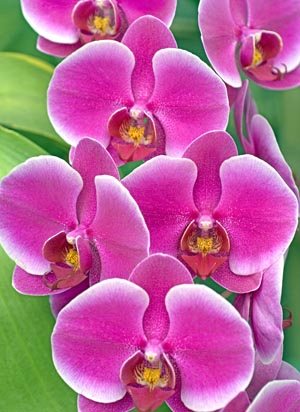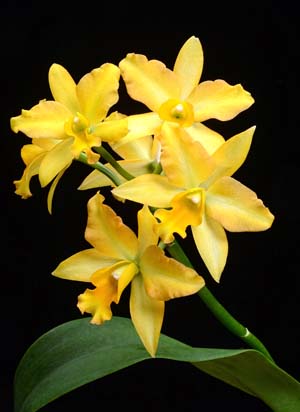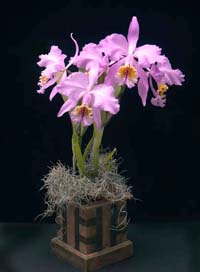|
Welcome to the AOS Beginner' Newsletter. We will be sending you monthly tips on how to grow orchids and help you get them to bloom again. In addition to the information presented here, we invite you to visit the AOS website at www.aos.org and check out the information found under ORCHID INFORMATION > ORCHID BASICS.
What to look for when buying an orchid plant

There are two ways to choose an orchid to buy. If you just want a plant with pretty flowers for your coffee table, like an azalea or daisies, then any plant that appeals to you will do. It doesn't matter if the plant has a name or not. Unnamed plants, "Noids" (meaning; no id) as they are popularly called on orchid forums, are readily available at any big box store for under $20.00. These are generic, unregistered plants and can provide you with beautiful blooms for many days. But if you find orchids interesting and want to know more about them, make sure your plant has a name. You'll find the name of your plant on a label stuck in the pot. At first, a label can be intimidating to read and interpret. The following information will help you unravel the mystery of a plant name.
HOW TO READ A PLANT LABELl
Pick up a plant label from one of your plants. Most likely, the name will consist of at least two words. The first word is the name of the genus (plural: genera). Think of genus name as a person's last name or family name. (e.g., Smith, Jones, Thompson). The genus name should be italicized whether it is a species or hybrid.
Within each genus there may be dozens, if not hundreds, of species. Taxonomists recognize these species by giving them individual names called specific epithets (these usually begin with a lower-case letter and are also in italics). A specific epithet may indicate place of origin (costaricensis, from Costa Rica), the person who found the orchid (besseae, for Libby Besse), a characteristic of the orchid (glabra, for smooth) or honor an individual (garayi, for Leslie Garay). Together, the genus name and specific epithet comprise the species name, and often impart a bit of information. Hence Masdevallia coccinea is a species with red flowers (coccinea means red) and Paphiopedilum philippinense was discovered in the Philippines. Think of the species name as a person's first name (e.g., Tom, Mary, Suzie or Christopher).
THE NAMES OF HYBRIDS
A major attraction of orchids is the diversity of hybrids available. Hybrids have names, too. When a hybrid is made, the breeder, or his or her representative, assigns a grex or group name that applies to all of the hybrid progeny. A grex name begins with a capital letter and is in Roman type. When Paphiopedilum niveum was crossed with Paphiopedilum tonsum, all progeny were given the name Paphiopedilum Olivia. In the time since this cross was registered in 1898, some plants with exceptionally fine flowers have been observed and assigned cultivar names to distinguish them. Your label might also have a cultivar name such as `Lorelei' or `Casa Luna' following the grex name.

Cultivar names may be applied to hybrids (Paph. Olivia `Lorelei') as well as species (Paphiopedilum appletonianum `Seascape'). A cultivar name begins with a capital letter, is in Roman type and set within single quotation marks. When vegetatively propagated -- through divisions, keikis (offshoots) or mericlones -- all derivatives of a cultivar will be genetically identical and possess the same cultivar name. This permits hobbyists to know exactly what to expect from a plant they purchase bearing this name.
You may also see some extra letters -- such as AM/AOS and HCC/AOS -- following the plants' names. These letters indicate that a flower quality award, has been granted. These awards may be given to both species and hybrids. The letters before the slash are an abbreviation for the award; AM is an Award of Merit, HCC a Highly Commended Certificate. The letters following the slash indicate the association that bestowed the award.
Greg Allikas
September 2009
Do you find this interesting?
There's more information on the AOS website!

Did You Know?
Around 1835 the prices of rare orchid plants skyrocketed. Particularly rare specimens commanded prices exceeding. £700 which translates to over £50,000 ($75,000) today! Although considered an investment at the time, naming rights also held a certain cachet. It was quite a status symbol to have an orchid carry your name!
Reinikka, Merle, A History of the Orchid, Timber Press, Portland Oregon, 1995, p. 29
During the height of "orchid fever" in England, Mr. Thomas Moss, a noted collector of orchids and tropical plants, received an orchid, which was named Cattleya mossiae (right) in 1838 to honor his wife who was the first to paint this orchid when it flowered in his greenhouse.
|

